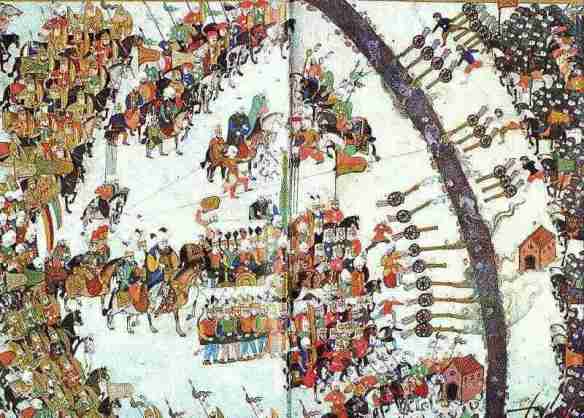The Battle of Keresztes (Also known as the Battle of Mezőkeresztes) (Turkish: Haçova Muharebesi) took place on 24–26 October 1596. The battle was fought between a combined Habsburg-Transylvanian force and the Ottoman Empire near the village of Mezőkeresztes (Turkish: Haçova) in northern Hungary. The battle ended with a victory by the Ottoman Empire. Lord Kinross, a early 20th-century historian, said that if the Ottoman Empire had been defeated, they would have lost Hungary and part of Bulgaria.
#
The Ottoman army marched through several passageways of marshy terrain and reached Haçova (Turkish meaning: Plain of the Cross), exhausted after a long siege and a hard, long march. The two armies faced each other on the plains of Haçova (Hungarian: Mezőkeresztes). The Austrian-Transylvanian army, under the joint command of Archduke Maximillian III of Austria and prince Sigismund Bathory of Transylvania, was in position in fortified trenches. When the Ottoman army attacked the Austrian trenches, the Battle of Haçova commenced and continued for two days, from 25–26 October 1596. Early firearms (cannons, rifles) were used extensively in the battle. The Austrians, being entrenched around the old ruined church, succeeded in driving back the Ottoman assaults with a barrage of cannon and musket fire.
By the second day of battle the Ottoman Army appeared to have been defeated. According to the 17th Century Ottoman historian İbrahim Peçevi:
“The Christians broke through the Ottoman army, but the soldiers of the Islam had not yet felt the defeat. Then, they started to plunder and taking of booty at the command headquarters of the Ottomans. Under a few flags, a large group of Christian soldiers attacked the tent where the chests of gold money of the Ottoman Exchequer were kept. They killed and otherwise eliminated the Janissary and household cavalry soldiers guarding the State Treasury. The Christian soldiers got on the Treasury chests of gold coin and put up their flags of cross over them and started to dance around them.”
Commander Sultan Mehmed III wanted to flee from the battlefield. However, first he asked for the opinion of his tutor, the high cleric Hoca Sadeddin Efendi, Efendi told the Sultan that he should continue the battle till the end. Heeding this advice, Sultan Mehmed III ordered that the battle should continue.
On the second day of the battle, the fighting intensified. Troops from the Austrian army had reached the Sultan’s tent, which was surrounded by the viziers and the teachers at the Palace Pages School for protection. While some troops were trying to enter the Sultan’s tent, the other Austrian army’s soldiers disengaged, in search of booty and plunder instead of continuing the engagement. The Ottoman horse groomers, cooks, tent makers, camels minders retaliated against the plunderers with whatever arms they could find, including cooks’ spoons, blocks of wood, hammers for tent making, adzes, and axes for cutting wood. The Austrians were surprised and retreated in confusion. The cries of “the Christian enemy is fleeing” were heard by the Ottoman troops still fighting what seemed like a losing battle on the frontline. The boost of morale allowed them to recover the battle. With a major action from the artillery, the Ottoman forces started another attack on the Austrians across the front and outflanked the Austrian-Transylvanian army, routing them.
Soon after victory, Mehmed III appointed Cigalazade Yusuf Sinan Pasha as the new Grand Vizier. He sent an imperial victory proclamation to Constantinople giving the news of the conquering of Egri (Erlau) Castle and the victory at the Battle of Haçova (Keresztes). This reached Constantinople in October and there were public celebrations and public meetings organized in the city. During these celebrations, four galleys full of state procured sugar from Egypt arrived at Constantinople harbor, which added “sweetness” to the news of a military victory. Mehmed III was awarded the epithet of ‘Conqueror of Egri’.
The Sultan’s army marched for a month, returning to Constantinople victorious. With the army in place, a great victory procession was organized. A victory procession and many accompanying spectacles were carried out. The poets of Constantinople wrote special works about the victory. In the streets and markets of the city, town-criers were sent to announce that the streets of the city would be decorated. The warehouses and stores were all decorated with ‘valuable cloths’. This display of colour all across the city is described in a poem by the poet [Kemal]:
“All the shops of the city became colored due to conquerors wishes
Each of which were decorated as if it were the kerchief of the sweetheart”
